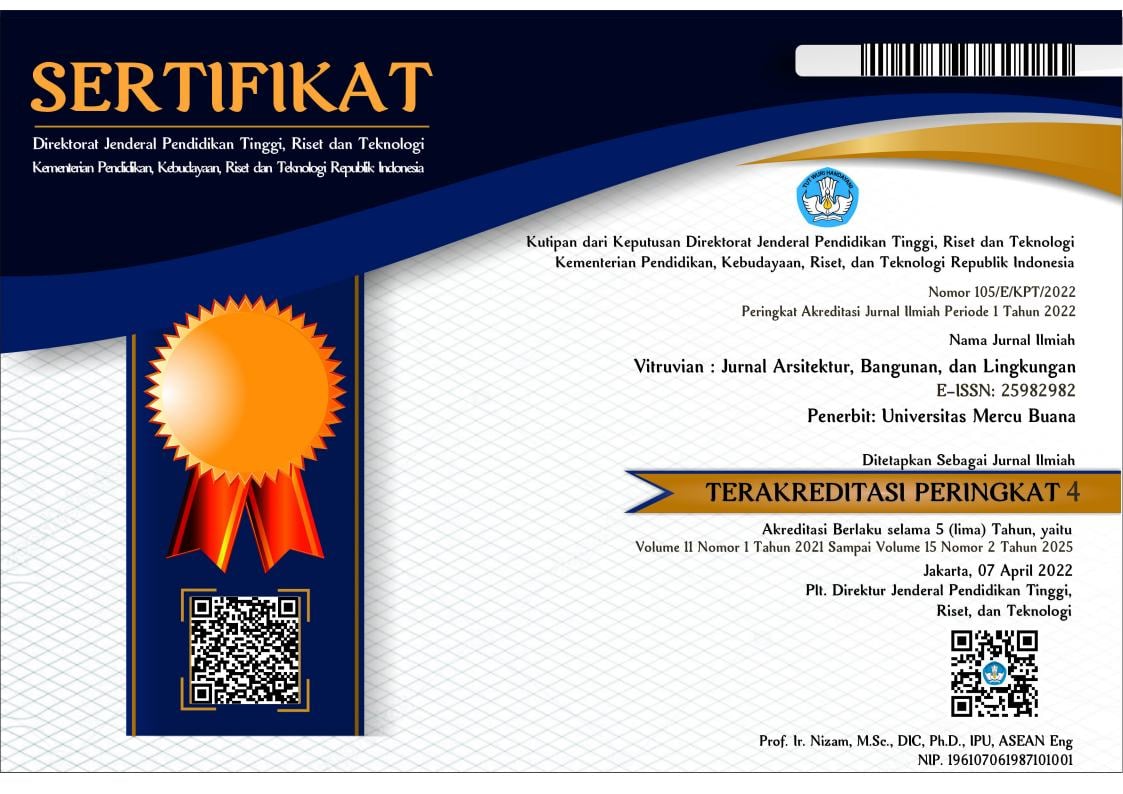DEFINING TERRITORIAL BEHAVIOUR AT KAMPUNG’S TRANSITIONAL SPACE
Abstract
Yogyakarta’s urban neighborhood, called kampung, encompasses the neighbouring life, shown in its transitional space. Territoriality in the context of kampung cannot be separated from the social ties between its residents, which builds familiarity. The leeway of transitional space use shows the specific behavior of Kampung’s residents towards territorial. Residents have their concepts in interpreting transitional space. There are different interpretations of territory and its significance. However, previous studies have not defined territorial behavior in the kampung context. This study was conducted qualitatively, located in two kampungs, Notoyudan and Prawirotaman. They have significant differences in terms of environmental typology and community background. This study focuses on defining territorial behavior in kampung through 1) a review of literature relating to territorial behavior by Altman (1976); 2) observing territorial phenomena; and 3) resuming the results toward the theory of territorial behavior. This research concludes that territorial behavior can be defined as a territorial transaction as a form of a resident’s social existence in the neighborhood. Territorial behavior becomes a spatial setting, reducing social disparities among Kampung’s residents. This behavior will continue, providing that transitional space still exist. This finding enriches the definition of territorial behavior and contributes to the theory of architecture behavior.
Keywords
Full Text:
PDFReferences
Arifin, F., & Ellisa, E. (2020). The adolescents gathering space at kampung in the Periphery of Tangerang Selatan City. IOP Conference Series: Earth and Environmental Science, 452(1). https://doi.org/10.1088/1755-1315/452/1/012128
Burgess, B. (2007). Seat Preferences in Different. Environment and Behavior, 39(6), 859–876.
Costa, M. (2012). Territorial Behavior in Public Settings. Environment and Behavior, 713 –721. https://doi.org/10.1177/0013916511403803
Ewing, R., Hajrasouliha, A., Neckerman, K. M., Purciel-Hill, M., & Greene, W. (2016). Streetscape Features Related to Pedestrian Activity. Journal of Planning Education and Research, 36(1), 5–15. https://doi.org/10.1177/0739456X15591585
Fitria, T. A., Rasidi, M. H., & Said, I. (2022a). the Forming of Spontaneous Social Interaction Place in Kampung Transition Area, Prawirotaman, Indonesia. Journal of Tourism, Hospitality and Environment Management, 7(27), 392–404. https://doi.org/10.35631/jthem.727031
Fitria, T. A., Rasidi, M. H., & Said, I. (2022b). The space privatization : The forming process of social space in kampung ,. Geografia - Malaysian Journal of Society and Space, 3(3), 251–263.
Griffiths, M. A., & Gilly, M. C. (2012). Dibs! customer territorial behaviors. Journal of Service Research, 15(2), 131–149. https://doi.org/10.1177/1094670511430530
Hardiyanti, N., & Devi, S. M. (2014). Warung Sebagai Ruang Berkumpul. Transukma, 1(1), 1–18.
Jesper, B., & Henrik, V. (2004). Multifunctional landscapes-motives, concepts and perceptions. Multifunctional Landscapes, 1, 3–32.
Kaya, N., & Weber, M. J. (2003). Environment and Behavior in Residence Halls. Environment and Behavior, 35(3), 400–414. https://doi.org/10.1177/0013916502250144
Landman, K. (2004). Who owns the roads ? Privatising public space in South African cities through neighbourhood enclosures. Privatisation of Urban Space, New Orleans, 26-27 February 2004, (February), 1–16. New Orleans.
Laurens, Joyce M. (2006). Pendekatan Perilaku Lingkungan dalam Perancangan Pemukiman Kota. Dimensi Teknik Arsitektur, 34(1), 19–30. Retrieved from http://puslit2.petra.ac.id/ejournal/index.php/ars/article/view/16453
Laurens, Joyce Marcella. (2012). Changing Behavior and Environment in a Community-based Program of the Riverside Community. Procedia - Social and Behavioral Sciences, 36(June 2011), 372–382. https://doi.org/10.1016/j.sbspro.2012.03.041
Madden, D. (2015). Cities Full of Symbols: A Theory of Urban Space and Culture. Contemporary Sociology: A Journal of Reviews, 44(1), 100–101. https://doi.org/10.1177/0094306114562201nn
Mehta, V. (2014). Evaluating Public Space. Journal of Urban Design, Vol. 19, pp. 53–88. Taylor & Francis. https://doi.org/10.1080/13574809.2013.854698
Middleton, J. (2018). The socialities of everyday urban walking and the ‘right to the city.’ Urban Studies, 55(2), 296–315. https://doi.org/10.1177/0042098016649325
Peters, K. (2010). Being together in urban parks: Connecting public space, leisure, and diversity. Leisure Sciences, 32(5), 418–433. https://doi.org/10.1080/01490400.2010.510987
Prayitno, B. (2013). An Analysis of Consolidation Patterns of Kampung Alley Living Space in Yogyakarta, Indonesia. Journal of Habitat Engineering and Design, 5(1), 99–112.
Ratna, N. D., & Ikaputra. (2019). Teritorialitas Dalam Tinjauan Ilmu Arsitektur. INERSIA, 15(1), 12–22. https://doi.org/10.21831/inersia.v15i1.24860
Setiawan, B. (2006). Ruang Bermain untuk Anak di Kampung Kota:Studi Persepsi Lingkungan, Seting, dan Perilaku Anak di Kampung Code Utara, Yogyakarta. Manusia Dan Lingkungan, 13(2), 60–70. https://doi.org/https://doi.org/10.22146/jml.18650
Tamariska, S. R., & Ekomadyo, A. S. (2017). ‘Place-Making’ Ruang Interaksi Sosial Kampung Kota’. Jurnal Koridor, 8(2), 172–183. https://doi.org/10.32734/koridor.v8i2.1345
Widiyastuti, D. (2013). Transformation of Public Space : Social and Spatial Changes. A Case Study of Yogyakarta Special Province , Indonesia. Technical University of Dortmund.
Zubaidi, F. (2019). Types and Patterns of Territory in the Traditional Settlement of Ngata Toro. Journal of Architecture&Environment, 18(2), 123. https://doi.org/10.12962/j2355262x.v18i2.a6029
DOI: http://dx.doi.org/10.22441/vitruvian.2025.v15i1.005
Refbacks
- There are currently no refbacks.
Copyright (c) 2025 Vitruvian : Jurnal Arsitektur, Bangunan dan Lingkungan
License URL: http://publikasi.mercubuana.ac.id/index.php/virtuvian/article/view/32264
Layout Jurnal Vitruvian:Download
Declaration & CTA Form Vitruvian:Download
(WAJIB DI UPLOAD SEBAGAI SUPLEMENTARY SAAT SUBMIT ARTIKEL)
Vitruvian
Program Studi Arsitektur
Fakultas Teknik Universitas Mercu Buana
Jl. Raya Meruya Selatan, Kembangan, Jakarta 11650
Tlp./Fax : +62215871335
Surel : [email protected]
p-ISSN : 2088-8201
e-ISSN : 2598-2982
Website : http://publikasi.mercubuana.ac.id/index.php/virtuvian
DOI : 10.22441/vitruvian
Vitruvian is indexed by the following abstracting and indexing services:

This work is licensed under a Creative Commons Attribution-NonCommercial 4.0 International License.








